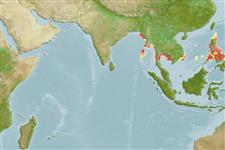Elasmobranchi (squali e razze) (sharks and rays) >
Orectolobiformes (Carpet sharks) >
Hemiscylliidae (Bamboo sharks)
Etymology: Chiloscyllium: cheilos (Gr.), lip, referring to membranous and broad lower lip, presumably of C. plagiosum (proposed without a species); skylion, Greek for dogfish or small shark. (See ETYFish); hasseltii: In honor of Dutch physician and biologist Johan Coenraad van Hasselt (1797-1823), who explored the colonial Dutch East Indies with his friend Heinrich Kuhl in 1820. (See ETYFish).
More on author: Bleeker.
Environment: milieu / climate zone / depth range / distribution range
Ecologia
marino associati a barriera corallina; distribuzione batimetrica 0 - 12 m (Ref. 90102). Tropical; 23°N - 10°N, 91°E - 133°E
Indo-West Pacific: Thailand, Singapore, Malaysia, Indonesia, Myanmar and Vietnam.
Size / Peso / Age
Maturity: Lm ? range ? - ? cm
Max length : 61.0 cm TL maschio/sesso non determinato; (Ref. 106604)
Short description
Morfologia | Morfometria
Spine dorsali (totale): 0; Raggi dorsali molli (totale): 0; Spine anali 0; Raggi anali molli: 0. Caudal fin with a pronounced subterminal notch but without a ventral lobe (Ref. 13575). Juveniles with dark grey-brown bands outlined in black, adults uniform medium- to dark-brown color, the black edgings being the last parts of the color pattern to disappear (Ref. 13575).
A common inshore bottom-dweller (Ref. 13575); on rock and coral reefs (Ref. 90102). Feeds on invertebrates (Ref. 13575). Oviparous (Ref. 50449). Utilized for human consumption (Ref. 13575). Minimum depth from Ref. 58018.
Life cycle and mating behavior
Maturità | Riproduzione | Deposizione | Uova | Fecundity | Larve
Oviparous, paired eggs are laid. Embryos feed solely on yolk (Ref. 50449). Distinct pairing with embrace (Ref. 205).
Compagno, L.J.V. and V.H. Niem, 1998. Hemiscylliidae. Longtail carpetsharks. p. 1249-1259. In K.E. Carpenter and V.H. Niem (eds.) FAO identification guide for fishery purposes. The Living Marine Resources of the Western Central Pacific. FAO, Rome. (Ref. 13575)
IUCN Red List Status (Ref. 130435)
Threat to humans
Harmless
Human uses
Pesca: commerciale
Informazioni ulteriori
Age/SizeAccrescimentoLength-weightLength-lengthLength-frequenciesMorfometriaMorfologiaLarveDinamica popolazioni larvaliReclutamentoAbbondanzaBRUVS
BibliografiaAcquacolturaProfilo di acquacolturaVarietàGeneticaElectrophoresesEreditarietàMalattieElaborazioneNutrientsMass conversion
CollaboratoriImmaginiStamps, Coins Misc.SuoniCiguateraVelocitàModalità di nuotoArea branchialeOtolithsCervelliVista
Strumenti
Special reports
Download XML
Fonti Internet
Estimates based on models
Preferred temperature (Ref.
123201): 27.9 - 29.1, mean 28.7 °C (based on 158 cells).
Phylogenetic diversity index (Ref.
82804): PD
50 = 0.5039 [Uniqueness, from 0.5 = low to 2.0 = high].
Bayesian length-weight: a=0.00407 (0.00181 - 0.00918), b=3.09 (2.89 - 3.29), in cm total length, based on LWR estimates for this (Sub)family-body shape (Ref.
93245).
Trophic level (Ref.
69278): 3.5 ±0.37 se; based on food items.
Resilienza (Ref.
120179): Basso, tempo minimo di raddoppiamento della popolazione 4.5 - 14 anni (Fec assumed to be <100).
Fishing Vulnerability (Ref.
59153): Moderate vulnerability (44 of 100).
